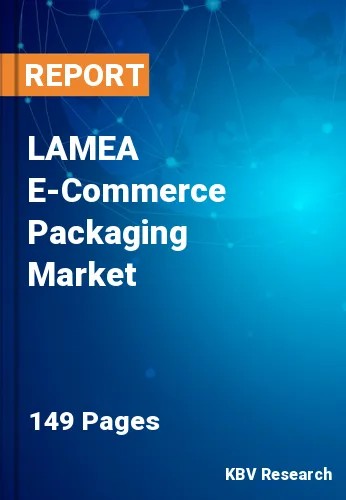The Latin America, Middle East and Africa E-Commerce Packaging Market would witness market growth of 12.3% CAGR during the forecast period (2023-2030).
Advanced tracking and monitoring systems in the form of smart labels and sensors allow customers to track the status and location of their packages in real-time. This transparency enhances the customer experience and reduces the risk of loss or theft. Solutions for protective packaging that are particular to the product's dimensions and fragility are using 3D printing technology. Blockchain technology is used to establish transparency and traceability in the supply chain. Blockchain-enabled packaging allows customers to confirm the origin and authenticity of products.
Edible packaging is an emerging concept, particularly in the food industry. Packaging made from edible materials reduces waste and offers a unique eco-friendly solution. For e-commerce packaging companies, social media influence offers a substantial market opportunity. With social media platforms' increasing prevalence and pervasiveness, businesses leverage these channels to promote their products and interact with their target audience. Packaging for e-commerce plays a crucial role in creating a memorable unboxing experience that consumers frequently capture and share on social media.
As per the International Trade Administration (ITA), the United Arab Emirates leads the Gulf Cooperation Council in eCommerce sales, which surged by 53% in 2020 to a record $3.9 billion, or 10% of overall retail sales. The Dubai Chamber of Commerce and Industry indicates that eCommerce will develop $8 billion in sales by 2025 as the UAE region has nearly 100 percent internet and mobile phone penetration. Additionally, ITA anticipates that 33.6 million Saudis will use the internet for e-commerce (buying and selling) by 2024, a 42 percent increase from 2019. Saudi Arabia has one of the greatest smartphone penetration rates in the world (97 percent), its mobile broadband internet subscriptions are higher than most advanced sectors, and it ranks tenth in the world for the fastest internet speed. With the rising adoption of the e-commerce sector across the LAMEA region, the market is estimated to increase.
The Brazil market dominated the LAMEA E-Commerce Packaging Market by Country in 2022 and would continue to be a dominant market till 2030; thereby, achieving a market value of $3,689.5 million by 2030. The Argentina market is showcasing a CAGR of 12.9% during (2023 - 2030). Additionally, The UAE market would register a CAGR of 12% during (2023 - 2030).
Based on Product Type, the market is segmented into Boxes, Protective Packaging, Labels, Mailers, Tapes, and Others. Based on Material, the market is segmented into Corrugated Boards, Paper & Paperboard, Plastic, and Others. Based on Application, the market is segmented into Electronics, Furniture, Cosmetics, Fashion, Food & Beverages, and Others. Based on countries, the market is segmented into Brazil, Argentina, UAE, Saudi Arabia, South Africa, Nigeria, and Rest of LAMEA.
Free Valuable Insights: The Worldwide E-Commerce Packaging Market is Projected to reach USD 132.7 Billion by 2030, at a CAGR of 10.4%
The market research report covers the analysis of key stake holders of the market. Key companies profiled in the report include Amcor Plc, Mondi Plc, The International Paper Company, DS Smith Plc., Rengo Co., Ltd., Sealed Air Corporation, Berry Global Group, Inc., CCL Industries Ltd., Sonoco Products Company and Smurfit Kappa Group plc.
By Product Type
By Material
By Application
By Country
Our team of dedicated experts can provide you with attractive expansion opportunities for your business.

